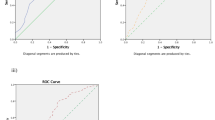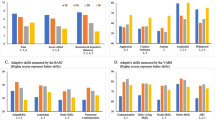Abstract
The high-functioning Autism Spectrum Screening Questionnaire (ASSQ) is a 27-item checklist for completion by lay informants when assessing symptoms characteristic of Asperger syndrome and other high-functioning autism spectrum disorders in children and adolescents with normal intelligence or mild mental retardation. Data for parent and teacher ratings in a clinical sample are presented along with various measures of reliability and validity. Optimal cutoff scores were estimated, using Receiver Operating Characteristic analysis. Findings indicate that the ASSQ is a useful brief screening device for the identification of autism spectrum disorders in clinical settings.
Similar content being viewed by others
REFERENCES
Achenbach, T. M., McConaughy, S. H., & Howell, C. T. (1987). Child/adolescent behavioral and emotional problems; Implications of cross-informant correlations for situational specificity. Psychological Bulletin, 101, 213–232.
American Psychiatric Association. (1994). Diagnostic and statistical manual of mental disorders, (4th ed.). Washington, DC: Author.
Asperger, H. (1944). Die autistischen Psychopathen im Kindesalter. Archiv für Psychiatrie und Nervenkrankheiten, 117, 76–136.
Asperger, H. (1991). “Autistic psychopathy” in childhood. In Frith, U. (Ed.), Autism and Asperger syndrome (pp. 37–92). Cambridge, U.K.: Cambridge University Press.
Barkley, R. A. (1988). Child behavior rating scales and checklists. In (Ed.), Assessment and diagnosis in child psychopathology. New York: Guilford.
Bosch, G. (1970). Infantile autism (D. Jordan & I. Jordan, Trans.). New York: Springer Verlag. (Originally work published 1962)
Bowman, E. P. (1988). Asperger's syndrome and autism: The case for a connection. British Journal of Psychiatry, 152, 377–382.
Boyle, M., & Jones, S. C. (1985). Selecting measures of emotional and behavioral disorders of childhood for use in general populations. Journal of Child Psychology and Psychiatry, 26, 137–159.
Conners, C. K. (1990). Conners Rating Scales Manual, Conners Teacher Rating Scales, Conners Parent Rating Scales. Instruments for use with children and adolescents. North Tonawanda, NY: Multihealth Systems.
Ehlers, S., & Gillberg, C. (1993). The epidemiology of Asperger syndrome. A total population study. Journal of Child Psychology and Psychiatry, 34, 1327–1350.
Einfeld, S. L., & Tonge, B. J. (1995). The Development Behavior Checklist: The development and validation of an instrument to assess behavioral and emotional disturbance in children and adolescent with mental retardation. Journal of Autism and Developmental Disorders, 25, 81–104.
Eisenmajer, R., Prior, M., Leekam, S., Wing, L., Gould, J., Welham, M., & Ong, B. (1996). Comparison of clinical symptoms in autism and Asperger's disorder. Journal of the American Academy of Child and Adolescent Psychiatry, 35, 1523–1531.
Fletcher, R. H., Fletcher, S. W., & Wagner, E. H. (1988). Clinical epidemiology. The essentials. Baltimore, MD: Williams & Wilkins.
Fombonne, E. (1991). The use of questionnaires in child psychiatry research: measuring their performance and choosing an optimal cut-off. Journal of Child Psychology and Psychiatry, 32, 677–693.
Gillberg, C. (1991). Clinical and neurobiological aspects of Asperger syndrome in six family studies. In Frith, U. (Ed.), Autism and Asperger syndrome (pp. 122–146). Cambridge U.K.: Cambridge University Press.
Gillberg, C. (1992). The Emanuel Miller Memorial Lecture 1991: Autism and autistic-like conditions: Subclasses among disorders of empathy. Journal of Child Psychology and Psychiatry, 33, 813–842.
Gillberg, C., & Ehlers, S. (1998). High-functioning people with autism and Asperger syndrome. A literature review. Journal of Autism and Developmental Disorders, 28, 79–106.
Gillberg, I. C., & Gillberg, C. (1989). Asperger Syndrome—some epidemiological considerations: A research note. Journal of Child Psychology and Psychiatry, 30, 631–638.
Goodman, R., & Minne, C. (1995). Questionnaire screening for co-morbid pervasive developmental disorders in congenitally blind children: A pilot study. Journal of Autism and Developmental Disorders, 25, 195–203.
Goodman, R. (1994). A modified version of the Rutter parent questionnaire including extra items on children's strengths: A research note. Journal of Child Psychology and Psychiatry, 35, 1483–1494.
Goyette, C. H., Conners, C. K., & Ulrich, R. F. (1978). Normative data on revised Conners parent and teacher rating scales. Journal of Abnormal Child Psychology, 6, 221–236.
Kanner, L. (1943). Autistic disturbances of affective contact. Nervous Child, 2, 217–250.
Kerbeshian, J. & Burd, L. (1986). Asperger's syndrome and Tourette syndrome: The case of the pinball wizard. British Journal of Psychiatry, 148, 731–736.
Krug, D. A., Arick, J., & Almond, P. (1980). Behavior checklist for identifying severely handicapped individuals with high levels of autistic behavior. Journal of Child Psychology and Psychiatry, 21, 221–229.
Miller, J. N., & Ozonoff, S. (1997). Did Asperger's cases have Asperger Disorders? A research note. Journal of Child Psychology and Psychiatry, 38, 247–251.
Nordin, V., & Gillberg, C. (1996). Autism spectrum disorders in children with physical or mental disability or both. Part II: Screening aspects. Developmental Medicine and Child Neurology, 38, 314–324.
Rutter, M. (1967). A children's behaviour questionnaire for completion by teachers: Preliminary findings. Journal of Child Psychology and Psychiatry, 8, 1–11.
Rutter, M., Graham, P., & Birch, H. G. (1996). Interrelations between the choreiform syndrome, reading disability and psychiatric disorder in children of 8–11 years. Developmental Medicine and Child Neurology, 8, 149–159.
Rutter, M., & Schopler, E. (1987). Autism and pervasive developmental disorders: Concepts and diagnostic issues. Journal of Autism and Developmental Disorders, 17, 159–186.
Rutter, M., Tizard, J., & Whitmore, K. (1970). Education, Health and Behaviour. London: Longmans.
Sackett, D. L., Haynes, R. B., Guyatt, G. H., & Tugwell, P. (1991). Clinical epidemiology. A basic science for clinical medicine (p. 441). Boston: Little, Brown.
Sanford, M. N., Offord, D. R., Boyle, M. H., Peace, A., & Racine, Y. A. (1992). Ontario child health study: Social and school impairments in children aged 6 to 16 years. Journal of the American Academy of Child and Adolescent Psychiatry, 31, 60–67.
Schopler, E. (1985). Editorial: Convergence of learning disability, higher-level autism and Asperger's syndrome. Journal of Autism and Developmental Disorders, 15, 359–360.
Schopler, E. (1996). Are autism and Asperger syndrome (AS) different labels or different disabilities? Journal of Autism and Developmental Disorders, 26, 109–110.
Streiner, D. L. (1993). A checklist for evaluating the usefulness of rating scales. Canadian Journal of Psychiatry, 38, 140–148.
Szatmari, P. (1992). The validity of autistic spectrum disorders: A literature review. Journal of Autism and Developmental Disorders, 22, 583–600.
Szatmari, P., Archer, L., Fisman, S., & Streiner, D. L. (1994). Parent and teacher agreement in the assessment of pervasive developmental disorders. Journal of Autism and Developmental Disorders, 24, 703–717.
Tantam, D. (1988). Asperger's syndrome. Journal of Child Psychology and Psychiatry, 29, 245–255.
Van Krevelen, D. A. (1971). Early infantile autism and autistic psychopathy. Journal of Autism and Childhood Schizophrenia, 1, 82–86.
Verhulst, F. C., & van der Ende, J. (1991). Four-year follow-up of teacher-reported problem behaviours. Psychological Medicine, 21, 965–977.
Wadden, N. P. K., Bryson, S. E., & Rodger, R. J. (1991). A closer look at the Autism Behavior Checklist: Discriminat validity and factor structure. Journal of Autism and Developmental Disorders, 21, 529–542.
Wing, L. (1981). Asperger's syndrome: a clinical account. Psychological Medicine, 11, 115–129.
Wing, L. (1986). Clarification of Asperger's syndrome. Journal of Autism and Developmental Disorders, 16, 513–515.
Wing, L. (1991). The relationship between Asperger's syndrome and Kanner's autism. In Frith, U. (Ed.), Autism and Asperger syndrome (pp. 93–121). Cambridge, U.K.: Cambridge University Press.
Wing, L., & Gould, J. (1979). Severe impairments of social interaction and associated abnormalities in children: Epidemiology and classification. Journal of Autism and Developmental Disorders, 9, 11–29.
Wolff, S., & Barlow, A. (1979). Schizoid personality in childhood: A comparative study of schizoid, autistic and normal children. Journal of Child Psychology and Psychiatry, 20, 29–46.
World Health Organization. (1993). The ICD-10 Classification of Mental and Behavioural Disorders. Diagnostic Criteria for Research. Geneva: Author.
Yirmiya, N., Sigman, M., & Freeman, B. J. (1994). Comparison between diagnostic instruments for identifying high-functioning children with autism. Journal of Autism and Developmental Disorders, 24, 281–291.
Author information
Authors and Affiliations
Rights and permissions
About this article
Cite this article
Ehlers, S., Gillberg, C. & Wing, L. A Screening Questionnaire for Asperger Syndrome and Other High-Functioning Autism Spectrum Disorders in School Age Children. J Autism Dev Disord 29, 129–141 (1999). https://doi.org/10.1023/A:1023040610384
Issue Date:
DOI: https://doi.org/10.1023/A:1023040610384




